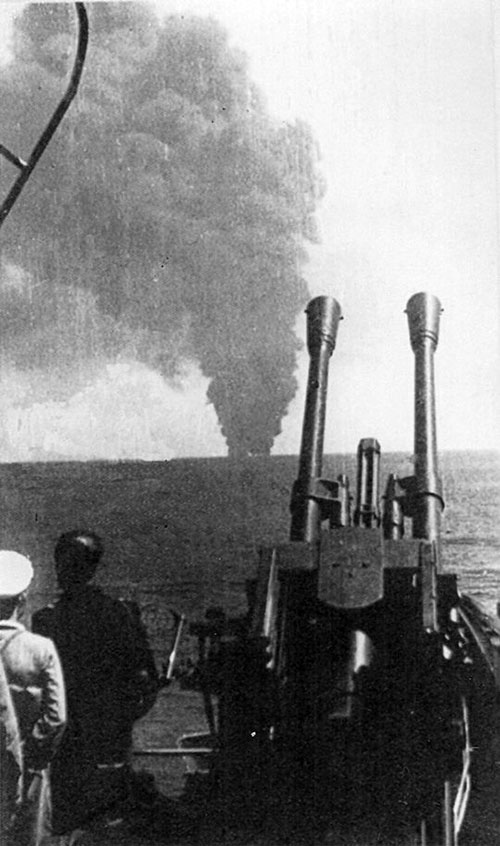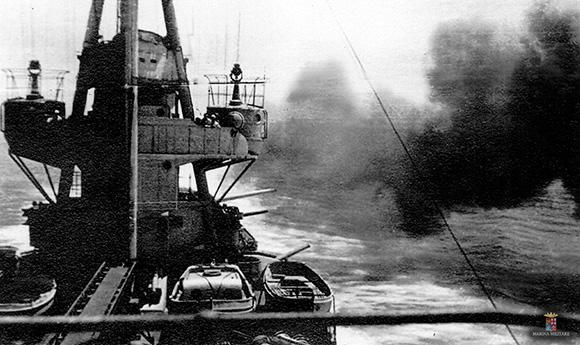June 1942: the Regia Marina has been involved for months in contrasting British convoys to Malta.
Malta, the British strategic base, is now at its last limit, a critical situation that leads the British to plan a refueling operation that gives a certain margin of success. For this, two convoys are prepared that simultaneously converge on Malta, from Gibraltar - operation Harpoon - and from Alexandria in Egypt - operation Vigorous.
The operation Vigorous foresees the larger of the two convoys escorted, however, by light cruisers and destroyers alone, as the British battle fleet in the eastern Mediterranean had been eliminated in one fell swoop following the Alexandria Night, the extraordinary victory that the Navy raiders had obtained in the previous December. Starting on 11 June, the convoy was subjected, starting from the afternoon of 12, to harsh and incessant attacks by the Italian and German sides, which caused numerous losses. On the morning of June 15, having received the news of the Italian fleet leaving Taranto, aimed at cutting the convoy's route, the British finally decided to return the ships to Alexandria, giving up supplying Malta from the east.
The simultaneous operation Harpoon provides a less numerous convoy, with a strong protection of warships reinforced by an additional heavy escort to the entrance of the Sicilian channel; this because the British high command considers that the Italian Navy uses only light forces in the channel, easily counterable by the English cruiser HMS Cairo and the destroyers of the close escort. As soon as they leave Gibraltar, the agents of the Navy's Secret Information Service operating in the area inform the Central Command (SUPERMARINA) which, starting from 12 June, prepares the appropriate countermeasures.

Submersible and torpedo boats are placed in the Channel of Sicily, lurking between Sardinia and Capo Bon, while the cooperation of the Regia Aeronautica and the X Germanic Luftflotte stationed in Sicily is requested. Already the 14 June the British convoy is the subject of the first attacks by the Axis air forces, which inflict extensive damage. After the heavy escort has reversed the route, the British convoy continues its march protected by an anti-aircraft cruiser and 9 destroyer.
But another appointment with destiny awaits, "Under the sign of Antares", the English convoy.
On the evening of the 14 June, the VII Italian Naval Division sails from Palermo under orders of Admiral Alberto Da Zara, destined to operate directly against enemy surface forces, composed of cruisers Montecuccoli (photo) ed Eugene of Savoy, together with the destroyers Oriani, Ascari, Premuda, Vivaldi e Malocello. After a masterful maneuver of deception, which allows them to escape the discovery of the enemy, the Italian units begin a long and very fast night run on the calm and favorable sea, illuminated by a perfect starry sky. In the direction of the enemy's origin, almost an omen, the constellation of Scorpio shines, with the brilliant star of Antares in the center.
At 5: 30 of 15 June, in the waters south of Pantelleria, the British, incredulous, are intercepted by the VII Naval Division that, without delay or hesitation, puts the bow on the enemy opening fire, at 5: 38, on ships in the vanguard of the English team. At the 5: 41 the "Seventh" has already downloaded 150 hits from 152 mm.
While trying to reorganize the British fleet begins to suffer also the air strikes of the Axis aircraft. From Zara he juggles between the smoke curtains spread by the adversary covering the units that are being hit.
In the excitement of maneuvers, it is hell. The admiral, as soon as he sees a passage through the smoke and has a free shooting range on the English merchant ships, attacks the convoy. A devastating offensive for the British, a "professional masterpiece" for Da Zara.
It is one of the best known surface actions in the history of the Italian Navy, as well as the daytime battle during which the greatest exchange of blows between the British and Italians takes place during the Second World War. During the battle, the VII Naval Division caused damage and losses to the opposing convoy such as to seal the complete victory of the Navy in the series of clashes that will go down in history as the "Battle of mid-June".
(Taken from the book "Pelle d'Ammiraglio")













